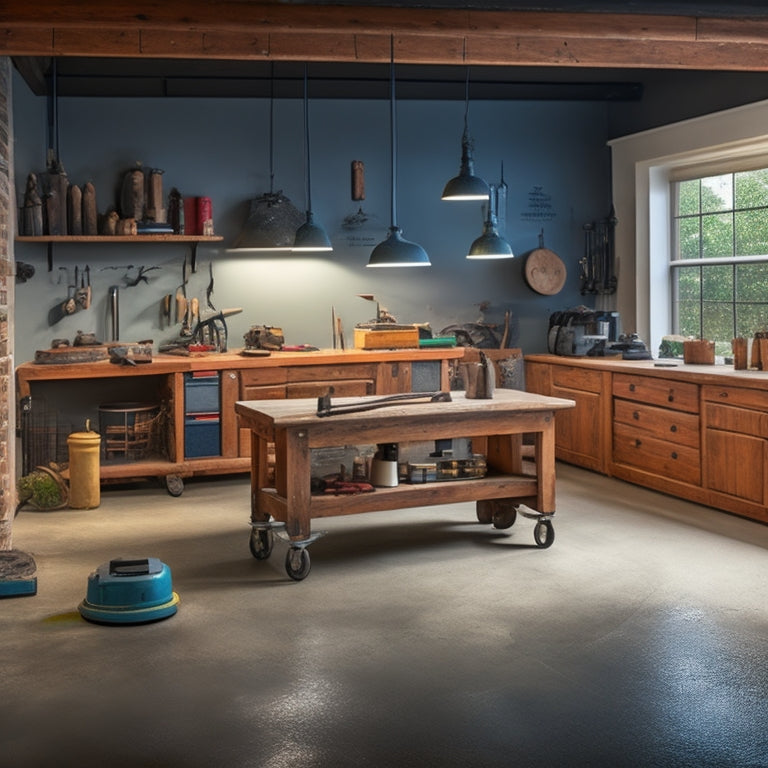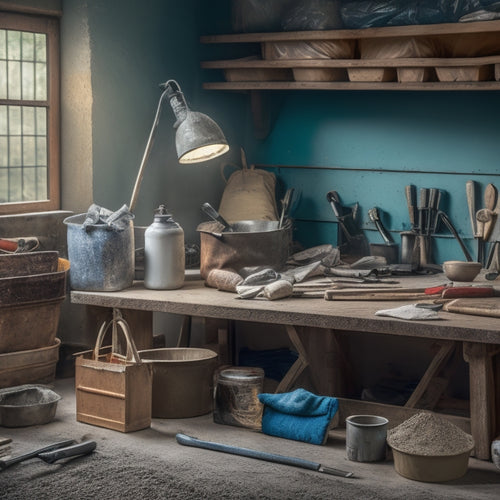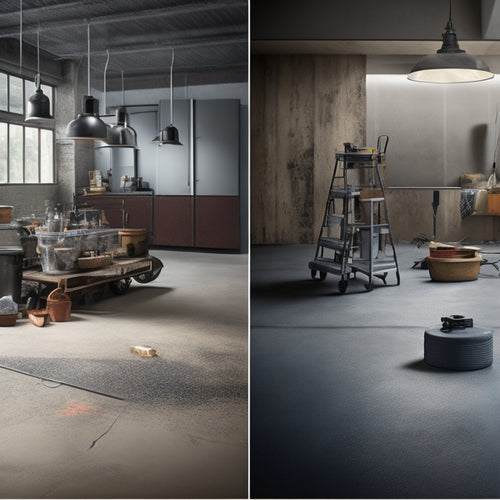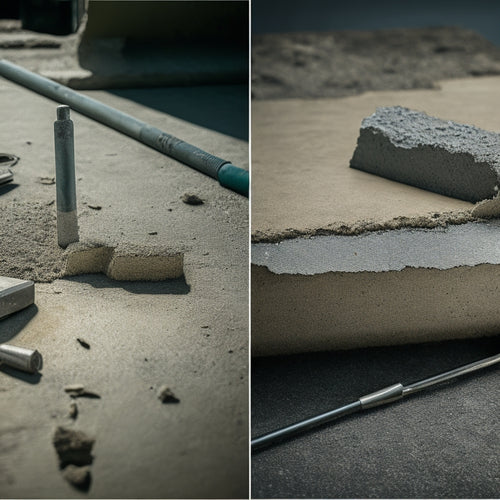
Top 10 Tools for Concrete Polishing Beginners
Share
As a concrete polishing beginner, you'll need the right tools to achieve a high-gloss finish and guarantee your safety on the job. Start with a reliable grinding machine, paired with metal-bond, resin-bond, and poly-bond diamond polishing pads for varying levels of aggression. A concrete floor edger will help you achieve a professional-looking edge, while a dust control system and essential safety equipment - including respirators, gloves, and goggles - will keep you protected. You'll also need polishing compounds, a concrete density scanner, a burnishing machine, and specialized cutting tools to tackle your project with confidence. Learn how to choose the best tools for your project and take the first step towards a flawless finish.
Key Takeaways
• Investing in a high-quality grinding machine is essential for efficient coating removal and achieving a high-gloss finish.
• Diamond polishing pads should be selected based on specific polishing process stages, with metal-bond pads for heavy scratches and poly-bond pads for final polishing.
• Concrete floor edgers with sufficient motor power and maneuverability are crucial for achieving a high-quality edge finish.
• Dust control systems with HEPA technology and high CFM requirements are vital for capturing airborne dust particles and ensuring health and safety.
• Safety equipment, including respirators, gloves, goggles, and steel-toed boots, is essential for protecting yourself from hazardous particles and chemical exposure.
Essential Grinding Machine Options
What kind of grinding machine do you need to get started with concrete polishing, and how do you choose the right one for your project?
As a beginner, you'll want a machine that can handle the demands of concrete polishing, which involves progressively finer grinding techniques to achieve a high-gloss finish. You'll need a machine with sufficient power, speed, and torque to efficiently remove old coatings, smooth out imperfections, and apply polishing compounds.
When selecting a grinding machine, consider the size of your project, the type of concrete you're working with, and the level of finish you want to achieve.
Look for a machine with adjustable speed settings, a sturdy construction, and a reliable motor. Additionally, think about machine maintenance - a machine that's easy to clean and maintain will save you time and hassle in the long run.
Best Diamond Polishing Pads
With your grinding machine in place, you'll need to select the right diamond polishing pads to achieve the desired level of shine and clarity in your concrete floor. This is where the magic happens, and your floor transforms from dull to dazzling.
When it comes to diamond pad types, you'll want to evaluate the following options:
-
Metal-bond diamond pads: These are the most aggressive and best for removing heavy scratches and imperfections.
-
Resin-bond diamond pads: Suitable for intermediate polishing stages, they provide a better finish than metal-bond pads.
-
Poly-bond diamond pads: The least aggressive, these are ideal for final polishing stages, producing a high-gloss finish.
Top polishing pad brands include 3M, Husqvarna, and Metabo. These brands offer high-quality diamond pads designed for specific stages of the polishing process.
Concrete Floor Edger Selection
When you're selecting a concrete floor edger, you're making a critical decision that will directly impact the quality of your finished floor.
You'll need to weigh factors like edge quality, bit selection, and maintenance requirements to guarantee you're getting the right tool for the job.
Edge Quality Matters Most
You'll quickly realize that achieving high-quality edges is crucial to a polished concrete floor's overall appearance, and selecting the right concrete floor edger is essential to this process. A well-chosen edger will help you master edge finishing techniques and create stunning edge design tips that elevate your floors from ordinary to extraordinary.
When it comes to edge quality, you can't afford to compromise. Here are three key considerations to keep in mind when selecting a concrete floor edger:
-
Edge profile: Will you be working on a straight edge, a curved edge, or a combination of both? Choose an edger that can adapt to your specific edge design needs.
-
Motor power: How much power do you need to tackle tough concrete surfaces? Look for an edger with a robust motor that can handle heavy-duty polishing tasks.
-
Weight and maneuverability: Will you be working in tight spaces or covering large areas? Opt for an edger that's lightweight, easy to maneuver, and won't fatigue you during extended use.
Choosing the Right Bit
Choosing the Right Bit
Selecting the right bit for your concrete floor edger is just as important as choosing the edger itself, as it directly impacts the quality of your edge finish. With so many diamond bit types available, it's crucial to understand their differences to make an informed decision. You'll want to take into account the type of concrete you're working with, the desired finish, and the edger's power output.
For example, a metal-bond diamond bit is ideal for aggressive grinding and removing thick coatings, while a resin-bond bit is better suited for finer polishing and honing.
You'll also need to factor in bit speed selection, as running a bit too fast can lead to overheating and damage to the edger or bit. A general rule of thumb is to start with a slower speed and gradually increase as needed.
Edger Maintenance Essentials
Proper maintenance of your concrete floor edger is critical to extending its lifespan, guaranteeing peak performance, and reducing downtime for repairs.
As a beginner, it's vital to understand that regular maintenance is key to getting the most out of your edger. You'll want to prioritize edger blade maintenance, as dull or damaged blades can lead to subpar results and even damage to your equipment.
Here are three routine inspection tips to keep in mind:
-
Check blade wear: Regularly inspect your edger blades for signs of wear, such as chipping or excessive dullness. Replace them promptly to maintain peak performance.
-
Inspect the edger's underside: Make it a habit to check the underside of your edger for debris accumulation, which can affect its performance and longevity.
-
Verify proper belt tension: Confirm the belts are properly tensioned to prevent slippage, which can lead to premature wear on your edger's components.
Efficient Dust Collector Systems
With efficient dust collector systems, your concrete polishing operation can capture up to 99% of airborne dust particles, markedly reducing the risk of respiratory problems and improving overall job site safety.
As you know, concrete dust is a serious health hazard, and having the right equipment is essential. When it comes to dust extraction techniques, you need a system that can handle high volumes of air and filter out even the smallest particles.
Look for effective filtration systems that use HEPA filters or similar technology to trap 99.97% of particles as small as 0.3 microns. A good dust collector system should also be able to handle the high CFM requirements of your polishing equipment.
Additionally, consider a system with a large dustbin capacity to reduce downtime for emptying. By investing in an efficient dust collector system, you'll be able to work faster, safer, and more efficiently, while also protecting your health and the health of your team.
Vital Safety Equipment Checklist
As you prepare to tackle concrete polishing projects, you're about to learn that safety isn't just a suggestion - it's a necessity.
You'll need to prioritize your well-being by investing in the right gear, and that starts with personal protective equipment that guards against physical harm.
Next, you'll focus on respiratory health essentials that prevent inhalation of hazardous particles and fumes.
Personal Protective Gear
You'll need to wear personal protective gear (PPE) that meets industry standards to safeguard yourself from the hazards associated with concrete polishing, including flying debris, dust, and chemical exposure. As a beginner, it's essential to prioritize your safety above all else.
Here are the important PPE items you should have:
-
Protective gloves: These will shield your hands from abrasions, cuts, and chemical splashes. Look for gloves with a grip to prevent dropping tools and a breathable material to keep your hands cool.
-
Safety goggles: Concrete polishing can generate a lot of dust and debris, which can easily damage your eyes. Safety goggles will protect your vision and guarantee you can work comfortably.
-
Steel-toed boots: You'll be working with heavy equipment and walking on uneven surfaces, so it's crucial to wear boots that can withstand impact and compression.
Respiratory Health Essentials
Concrete polishing generates hazardous airborne particles, requiring the use of respiratory protection to prevent serious health issues.
As you start polishing, you're not just dealing with dust - you're dealing with silica, heavy metals, and other toxic substances that can cause respiratory problems, lung disease, and even cancer.
Don't take the risk - invest in proper respiratory protection.
You'll need a respirator that can filter out 99.97% of particles as small as 0.3 microns.
Look for one with an assigned protection factor (APF) of at least 10, and make sure it's NIOSH-approved.
You should also consider a powered air-purifying respirator (PAPR) for added protection and comfort.
Top Concrete Sealer Applicators
Selecting the right applicator for your concrete sealer is essential, since it directly impacts the evenness and durability of the final finish.
You'll want to evaluate the type of concrete sealer you're using, as well as the specific application techniques required for the job. For instance, if you're working with a solvent-based sealer, you'll need an applicator that can handle the solvent's evaporation rate.
Here are three top applicators for concrete sealers:
-
Microfiber Mops: Ideal for water-based sealers, microfiber mops provide an even, consistent application and are easy to clean.
-
Lambswool Applicators: Perfect for solvent-based sealers, lambswool applicators allow for a smooth, even application and can handle the solvent's evaporation rate.
-
Foam Applicators: Great for acrylic sealers, foam applicators provide a consistent, even application and are easy to use on large surfaces.
Beginner-Friendly Polishing Compounds
With your sealer applied, it's time to bring out the best in your concrete floor by choosing the right polishing compound to achieve a high-gloss finish. As a beginner, you'll want to focus on compounds that are easy to use and provide consistent results.
When selecting a polishing compound, consider the type of concrete you're working with, as well as the desired level of shine. For beginners, it's best to start with a hybrid polishing compound that can be used for both wet and dry polishing techniques. This will give you flexibility and allow you to experiment with different methods.
When comparing compounds, look for products with high-quality abrasives and a low risk of scratching or discoloring the concrete. Some popular beginner-friendly polishing compounds include those from well-known brands like 3M, Husqvarna, and Miry.
These products are designed to be user-friendly and provide excellent results, even for those new to concrete polishing. By choosing the right polishing compound and mastering basic polishing techniques, you'll be able to achieve a stunning, high-gloss finish that will impress clients and enhance the beauty of your concrete floor.
Concrete Density Scanner Tools
Measuring the density of your concrete floor becomes essential as you progress towards achieving a high-gloss finish, and that's where concrete density scanner tools come into play. These tools help you determine the concrete density measurement, which is critical in identifying areas that require more attention during the polishing process. With accurate readings, you can adjust your polishing techniques to achieve ideal results.
Here are three essential tips to get the most out of your concrete density scanner tools:
-
Calibrate your scanner regularly: Verify your scanner is calibrated according to the manufacturer's instructions to guarantee accurate readings.
-
Take multiple readings: Take readings at different points on the floor to get a thorough understanding of the concrete density.
-
Use the data to adjust your polishing strategy: Based on the readings, adjust your polishing technique, including the type of polishing compound and grinding sequence, to achieve the desired finish.
High-Quality Burnishing Machines
You'll need high-quality burnishing machines to achieve a flawless, high-gloss finish, as they play a critical role in removing scratches and imperfections from your polished concrete floor. These machines are designed to handle intense polishing tasks, making them an essential investment for any concrete polishing beginner.
Look for burnishing machines with high-performance features such as powerful motors, advanced gear systems, and adjustable speed controls. These features will enable you to tackle even the toughest polishing jobs with ease and precision.
When choosing a burnishing machine, also consider the importance of user-friendly controls. A machine with intuitive controls will allow you to focus on the polishing process, rather than struggling to operate the equipment.
Additionally, look for machines with durable construction, high-quality components, and reliable performance. By investing in a high-quality burnishing machine, you'll be able to achieve a showroom-quality finish that will impress even the most discerning clients.
With the right machine, you'll be well on your way to delivering exceptional results and building a reputation as a skilled concrete polishing professional.
Specialized Concrete Cutting Tools
When you're working with concrete, having the right cutting tools is essential.
You'll want to invest in specialized concrete cutting tools that boast cutting-edge technology, ensuring a precise and efficient cut every time.
With these advanced tools, you'll be able to tackle even the toughest projects with confidence.
Cutting Edge Technology
With the advent of advanced concrete polishing, specialized cutting tools have become essential for achieving ideal results. Investing in these cutting-edge technologies can greatly enhance your workflow and final product. You'll be amazed at how these innovative tools can streamline your process and deliver exceptional results.
Here are three cutting-edge technologies you should consider:
-
Smart Automation: Invest in smart automation systems that allow you to program and control your cutting tools with precision. This technology enables you to optimize your cutting process, reduce labor costs, and increase productivity.
-
Innovative Materials: Explore cutting tools made from innovative materials like diamond-coated blades or advanced ceramic blades. These materials offer superior cutting performance, longer lifespan, and reduced maintenance costs.
-
Advanced Cooling Systems: Implement advanced cooling systems that prevent overheating and reduce wear on your cutting tools. This technology guarantees consistent performance, extends tool lifespan, and minimizes downtime.
Precise Blade Design
By incorporating cutting-edge technologies, you can now focus on refining your concrete polishing process with specialized cutting tools, such as precisely designed blades that further enhance your workflow. One essential aspect of these blades is their material type, which greatly impacts their performance and durability.
| Blade Material Type | Ideal Blade Angle |
|---|---|
| Diamond-impregnated | 20-30° for aggressive cutting |
| Carbide-tipped | 30-40° for medium-aggressive cutting |
| Ceramic-coated | 40-50° for fine, precise cutting |
| Tungsten-carbide | 50-60° for extra-fine, precise cutting |
When selecting a blade, consider the specific demands of your project, including the type of concrete, desired finish, and desired removal rate. For instance, diamond-impregnated blades are ideal for aggressive cutting and removing thick layers of concrete, while ceramic-coated blades are better suited for fine, precise cutting and achieving a high-gloss finish. By choosing the right blade material type and ideal blade angle, you can enhance your concrete polishing process, increase efficiency, and achieve professional-grade results.
Efficient Dust Control
You'll need to contain the dust generated during concrete cutting by utilizing specialized tools that effectively capture and filter airborne particles, ensuring a safer and more efficient polishing process. This is where efficient dust control comes into play. As a beginner, it's vital to invest in tools that incorporate advanced dust extraction techniques and effective filtration systems.
Here are three must-have tools for efficient dust control:
-
Dustless concrete saws: These saws are equipped with vacuum systems that capture dust and debris as you cut, reducing airborne particles by up to 99%.
-
Dust extractors with HEPA filters: These extractors use high-efficiency particulate air (HEPA) filters to capture 99.97% of particles as small as 0.3 microns, ensuring a cleaner work environment.
-
Vacuum-assisted grinding tools: These tools use vacuum systems to capture dust and debris generated during the grinding process, reducing the risk of respiratory issues and improving overall air quality.
Frequently Asked Questions
Can I Polish Concrete Floors With a Low Horsepower Grinder?
You're wondering if you can polish concrete floors with a low horsepower grinder?
While it's technically possible, you'll likely face limitations. A low horsepower grinder will struggle to produce the required torque, resulting in subpar grinder performance.
You'll end up with a slower process, increased labor, and potentially uneven results.
If you're serious about achieving a high-gloss finish, consider investing in a more powerful grinder that can handle the demands of concrete polishing.
Do I Need to Use a Specific Type of Water for Concrete Polishing?
Are you ready to uncover the secret to achieving a showroom shine on your concrete floors?
When it comes to concrete polishing, the type of water you use matters. You'll want to avoid tap water, which can contain minerals that interfere with polishing techniques.
Instead, opt for deionized or distilled water to guarantee a flawless finish.
Trust us, the difference is worth the extra effort!
How Often Should I Change My Diamond Polishing Pads?
When it comes to diamond polishing pads, you'll want to keep a close eye on their lifespan.
Typically, you'll need to change them every 1,000 to 2,000 square feet, depending on the grit and usage.
Proper polishing pad maintenance is key to achieving ideal results.
You'll know it's time to swap them out when you notice a decrease in performance or visible wear.
Stay on top of this, and you'll be well on your way to achieving a showroom-worthy finish.
Can I Use a Concrete Polisher on Freshly Poured Concrete?
When you're working with freshly poured concrete, you need to exercise caution.
It's crucial to wait until the concrete has cured and hardened, typically 28 days, before attempting to polish it.
Fresh concrete considerations, such as high moisture levels and potential for damage, demand a more nuanced approach.
You'll need to adjust your polishing techniques overview to accommodate the unique needs of new concrete, taking it slow and steady to achieve ideal results.
Is It Necessary to Seal Concrete After Polishing It?
You're probably aware that 80% of concrete floors are sealed to protect them from damage.
Now, about your polished concrete - is sealing necessary? Absolutely!
Sealing benefits include enhanced durability, stain resistance, and easier maintenance.
When it comes to sealing techniques, you'll want to choose between topical, penetrating, or hybrid sealers, depending on your floor's specific needs.
Conclusion
As you commence your concrete polishing journey, remember that having the right tools is like building a strong foundation - it's essential for a flawless finish.
Just like a master chef needs quality knives, a concrete polisher needs high-quality equipment. With the right tools, you'll be able to transform dull, rough surfaces into glossy, showroom-quality floors.
Don't be like the contractor who showed up on a job site with a dull blade, only to struggle through the project. Invest in the best, and watch your skills shine.
Related Posts
-

10 Must-Have Tools for Small Concrete Projects
When tackling small concrete projects, you'll need a range of essential tools to achieve professional-grade results. ...
-

Top Tools for Revamping Old Concrete Floors
You'll need a range of tools to revamp your old concrete floor, starting with epoxy, acrylic, or polyurethane paint, ...
-

Top Tools for Concrete Adhesion Success
When it comes to concrete adhesion success, you'll need to wield the right tools and techniques to guarantee a strong...


